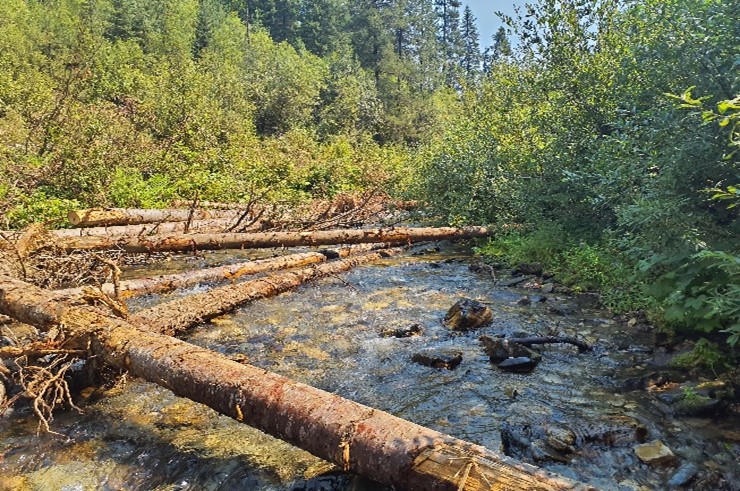Upper St. Joe River Bull Trout Habitat Enhancement

Status: In Progress
Location:
The project area includes 15 miles of occupied bull trout spawning and rearing tributaries of the Upper St. Joe River, located approximately 20 miles southwest of St. Regis, MT. Tributary streams include Red Ives Creek, Heller Creek, Sherlock Creek, Medicine Creek, Wisdom Creek, and Simmons Creek. The project is located within T42N, R11E, Sections 6, T43N, R9E, Sections 14-15, and 20-21, T43N, R10E, Sections 3-4, 9-11, 14-16, 20-22, 24, and 36, T43N R11E, Sections 19 and 29-31, T44N, R9E, Sections 19-27, T44N, R10E, Sections 30-33.
Background:
Bull trout redd counts have declined over 80% in the past 13 years in index streams in the Upper St. Joe River and its tributaries. The primary goal for the Upper St. Joe Bull Trout Habitat Enhancement Project is to fortify habitat to benefit all life stages of bull trout in approximately 15 miles of the only remaining occupied spawning and rearing habitat in the Coeur d’Alene basin. These Upper St. Joe River tributaries have been impacted by historic mining activities and large fire events, which left the identified treatment sections largely devoid of large woody debris and disconnected from their floodplains. The resulting homogenous habitat consists of long riffles with few pools in a stable hydrologic system. Project activities would return streams to as close to baseline conditions as possible, by improving hydrologic function and encouraging instream habitat complexity and floodplain connectivity. The Climate Shield temperature model predicts that the proposed tributary streams will remain as cold water refugia which benefits both threatened bull trout and all other native aquatic species (Isaak et al. 2015). Modeling from Isaak et al. (2022) suggests that targeted restoration to improve the resilience of existing strongholds could have significant conservation benefits for bull trout. The Restoration Plan lists this as a Tier 2 priority watershed for providing spawning, rearing, and other essential habitat for threatened bull trout. Westslope cutthroat trout will also benefit from habitat improvements.
Progress:
Planning for this project is ongoing, and it is likely that the planning, implementation, and portions of the monitoring phases of the project will overlap. Due to the short operating season, limited access and remoteness of the streams, the project will be phased over the next decade. This project contributes to and connects other restoration work that has been conducted in the Red Ives, Heller, Sherlock, and Simmons Creek drainages. The objective of the project is to strategically provide the streams with natural, native materials needed to support fluvial processes and maintain “dynamically stable” systems. Aquatic habitat will be complex and varied, providing for the needs of multiple aquatic and riparian-dependent species during their various life stages. Floodplains will be hydrologically and ecologically functional, with thriving riparian plant communities and recharged groundwater flows to keep stream temperatures cool via hyporheic exchange. Water quality will support fish populations that require clean, cool water for spawning and rearing activities.
Plans:
Benefits:

This project would protect and restore habitat function and processes in the highest value bull trout spawning and rearing streams. The proposed treatment streams in the Upper St. Joe Basin are currently and projected to remain cold water refugia and stronghold habitat for westslope cutthroat and threatened bull trout. Placement of large wood to provide instream structure, diversify habitat and initiate natural fluvial processes would enhance long-term natural processes. These natural processes would encourage hyporheic exchange with cooler groundwater and help release water more slowly after precipitation so that cooler streamflow sustained longer into warmer season, improving resiliency to the ongoing effects of climate change. Stream restoration activities would rely on low-tech, process-based approaches that have minimal negative effects on natural resources and would result in long-term beneficial effects to aquatic and riparian resources.
Contact:
Wade Jerome
Restoration Biologist
Idaho Panhandle National Forests
173 Commerce Drive
Smelterville, ID. 83868
p: 208-783-2363 x2127
c: 208-512-5097
Terry.Jerome@usda.gov
Ari Cummings
Fisheries Biologist
Forest Service
Idaho Panhandle National Forests
222 South 7th St., Suite #1
St. Maries, ID 83861-1847
p: 208-245-6045
c: 208-582-8291
ariel.e.cummings@usda.gov
Sponsor:
Partners:
